
[Photo] Traveler Taj Terpening
130 kilometers an hour is not normally an alarming speed, but Cass was not looking at the road. He jerked the e-brake and we skidded sideways past a sign that read “The Road to Nowhere.” With his right foot firmly planted on the gas and his left knee steering us around another blind corner in the wrong lane, Cass fidgeted with his camera and snapped a picture of the speedometer. “Frickin’ wicked!” he exclaimed in a thick Newcastle accent. After returning his eyes to the rapidly deteriorating road he shouted over the wind and the straining engine, “130 kilometers an hour! I think we’ve got them beat!”
Southern Spain, where perpetual chaos and sunshine are practically the national mottos, has always intrigued me. Chaos pervades all Mediterranean countries except Greece. The Italians invented the idea, and evidently the Spanish found it so appealing they took it up and eventually passed it on to Mexico. Thankfully Americans are too obsessed with their own personal space and obeying rules to embrace the same kind of chaos found in southern Europe. But perhaps more importantly, Spain is full of climbing, particularly in the south along the sea between Barcelona and the Straights of Gibraltar. La Costa Blanca collects climbers from around the world itching to climb sea cliffs roped or solo, ascend massive monoliths or hump tufas ’til their hearts are content. The idyllic island of Mallorca, La Costa Daurada near Barcelona and the adventure climbing playground El Chorro aren’t too shabby either. [Read Traveler’s September 12, 2007 Weekly Feature on El Chorro for more riotous escapades. –Ed.]
Some say that when traveling, the journey is the destination. Normally I agree, but for this trip from my home in Berlin to Alicante, Spain, I foolishly chose Ryan Air. Ryan Air is a low-cost British airline that looks great from the safety of your home computer. Their rates are fantastic, and their image suggests professionalism. The reality is that they allow only 14 kilos of check-on baggage, and I have a suspicion they recruited their employees straight out of Britain’s highest security asylum for the criminally insane. Moreover, the meals they sell you at extortive rates seem to have been compiled from leftovers gleaned from other, more respectable airlines. For each additional kilo of check-on baggage they charge the outrageous rate of 7 Euros. Because the American economy is collapsing and I travel with a lot of cams, that translates to… a hell of a lot of US dollars!
I darted out of the check-in line when I realized the petite, smiling employee would not only win the argument but might also make me cry if I continued to question the ethics and legality of the fee. I crunched the numbers quickly in my head and discovered that the extra fee for my bag would be coincidently the exact balance of my checking account and an entirely unacceptable amount. If Ryan Air was going to be devious and deceptive, so was I. So I stashed 38 pounds of quick draws, cams and rope in my clothes until I looked like a Michelin Man dressed for the Arctic. Sweating miserably, I finally boarded the plane, which had been held on my account. Adding to the indignity of the situation, my seat was in the very back. From the entrance at the front I held my bulk in place with both hands and waddled down the aisle, suffering cruel looks and comments for thirty rows.
I emerged into the 90-degree heat of Alicante and bolted across the tarmac, dodging luggage cars and bored teenagers with orange vests and light wands. Reaching the sanctuary of the airport restroom, I tore off layer after layer of sweat-soaked clothing. A restroom patron looked on in horror as cams, quickdraws and other bits of stashed climbing gear fell to the floor from their hiding places. The last item before I was free was a cleverly stashed 70-meter rope, dispersed evenly between my pant legs and jacket arms.
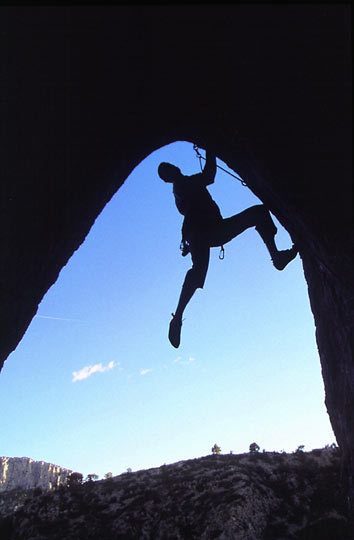
[Photo] Traveler Taj Terpening
Reluctantly oozing from the airport’s cool bowels, I pondered the questions: “Where is the climbing, how do I get there, and why is it so damn hot?” The first two questions I decided to address immediately. In response to disappointing trips elsewhere in the world with no plan and no climbing partner, I developed a technique I dubbed “trolling.” In the sea of people that usually congeal outside a plane, bus or train, the climbers in the horde are not always as obvious as one might think. With the popularity of climbing these days, many climbers are clean, perfectly respectable people who seamlessly blend into civilized society. Trolling is often necessary to separate these people from a crowd. The idea is simple: if you look like a climber and a bit like a lost puppy, other climbers will come to you and hopefully take you in. In the old days it seemed life for a marauding climber was easier. I would simply scan for the nearest guy sporting a three-day shadow with a bit of tuna stuck to it, and that person was most likely a pillar of the climbing community.
I began trolling by strapping my new bright yellow rope to the outside of my pack and clipping every bit of climbing hardware I owned to its many straps. Stumbling through the Spanish mob, I pretended to look intent and purposeful but I suppose I came off as merely sweaty and desperate. After a while I sat down on a bus bench, defeated. Leaning back with my eyed closed to the sun, a shadow covered my face. Expecting the worst I peered up to find two immense Norse goddesses towering above me. Success! The younger one began speaking in blather. I stared blankly for some time before she said, in perfect English, “You’re obviously not Swedish. Do you speak English?” Less than one hour in Spain and I had meet two Swedish climber women with a car. What a place!
They obviously had engaged in something they called “planning” before leaving home: they were in possession of not only a car, but also numerous maps and descriptions for every climbing area for miles. From the airport we made our way north along the Mediterranean coast, then inland to a crag perched high on the hillside overlooking orange orchards and distant, white limestone cliffs. Gandia is known for its very short and powerful routes. When I left Berlin I thought I was in shape, but climbing with these women made me feel like a mortal belaying Gods. They were more attractive, better climbers, fluent in more languages and even spoke better English than I. In general, they were superior human beings.
Though the climbing at Gandia was fantastic, unfortunately the crag sticks in my mind as the place where the Swedes ditched me and I ended up sleeping alone in a cave for six days while a family of pack rats harvested my down sleeping bag for their nests. Surviving on nothing but oranges pilfered from the nearby orchards, I made the startling discovery that one can get too much vitamin C after all.
After nearly a week sleeping in the cave, I anxiously watched as two cars–enveloped in a plume of dust, pumping British garage hip-hop–approached the crag. The Brits that emerged were socially inept, weak and fun as hell… I felt right at home. We climbed together for a few hours before I laid out my whole desperate situation.
“Look” I said, “I don’t have any money, and I barely speak the native tongue. I haven’t bathed in a week and pack rats have eaten most of my sleeping bag. I really don’t have much to offer your group, but you seem like a great bunch of guys and I’d like to come with you.” Either responding to my tearful honesty or out of pity, they took me into their circle with warmth and good humor.
They were engineers on holiday from England, and as far as I could make out, they survived solely on tea, white bread, booze and crude humor. Cass was the youngest of the group and also the funniest. He was happy to belay and climb in a laid-back, but safe manner for hours, joking and teaching me new bits of British slang.
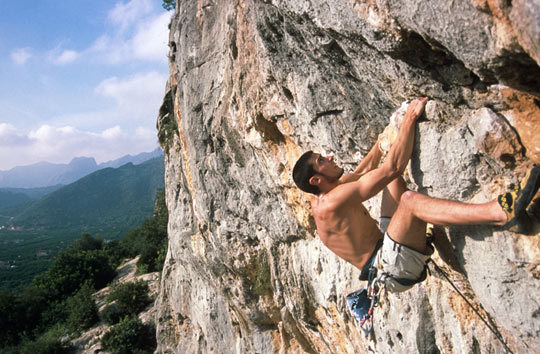
[Photo] Traveler Taj Terpening
The group had rented two cars for their holiday, a Fiat and a Renault. As an American these brands had always sounded exotic and luxurious. Cass set me straight: “One is Italian and one is French; both are shit.” Another misconception I did away with in short order was the idea that like all Europeans, The British are cultured and worldly. While some surely are, these chaps were definitely not.
The Brits had a flat in a fantastic area, central to an array of climbing. Within an hour we could be anywhere to eat, drink, swim or climb. Just north and inland was an amazing area called Sella, one of southern Spain’s most expansive and beautiful climbing areas. A few miles from the coast this mountain environment is far cooler and quieter than the hot and busy coast. A massive valley filled with dry pine forests splits the mountains in a jagged line toward the sea and smells of vanilla and olives when the sun shines. Along the valley’s flanks are massive white limestone cliffs rising to 300 meters. At the valley’s entrance is an orchard of ancient olive trees and a stone house that’s been converted to a climbers’ refuge. Looming just behind the refuge is the inspiring 300-meter Divino Wall. People from all over the world gather at the refuge each evening to eat, sleep and tell stories in every language imaginable.
Presiding over the hostel was a young Spaniard who spent the majority of his time laying in the sun on an old mattress under an olive tree with a hat over his face and a radio positioned an inch from his ear. Because he was so incredibly stationary for such amazingly long periods of time, most people feared him and would not have wakened him for the world. As a result, visiting climbers simply left rent money on or near him anchored with a stone. One also could pay the fee with a little weed, or if none was available he would accept cash, which he would use to buy the weed himself. The result was comical: a man fast asleep surrounded with money, baggies of weed and dried olives. Once or sometimes twice a week he would stir from his mattress and actually climb something, often just doing one 5.13 or harder in perfect style with no falls. He would then return with much relief to his position on the mattress below the olive tree.
Cass and I ventured to Sella whenever we could, finding only a few tufas but some incredible, long, sparsely featured climbs with amazing views all the way to the sea. A climb that was not so long but circumnavigated an amazing natural feature of the mountain was called Ojo del Odra (5.11b). A massive fin of white and grey limestone cut through the lush pine forest, cleaving the valley in two. In the middle of this fin of rock was a single hole, which allowed climbers to walk from one side to the other without trekking miles around. We flipped a coin and Cass racked up. Dramatically overhung and thinly bolted the climb ascended in an elegant spiral from inside the passageway out into the sunshine and up some steep pocketed terrain. We were both extremely intimidated.
“Clip, jump, grab, hand in dark scary hole, then figure out the rest,” Cass whispered to himself as he stood at the starting move. Driven by fear he moved quickly through the first sequence, clipped then jumped for the dark hole. “Bird shit!” he yelled as he came tight on the rope and a legion of terrified pigeons fled the hole assuming, no doubt, the bird apocalypse was upon them.
“It’s a proper aviary in there!” he laughed.
Over the course of the day we worked the move, pulled the roof and made the chains, choosing to rate the climb a little harder because we had to skip the aviary hold on each ascent.
Another amazing feature of La Costa Blanca is the Penon d’lfach outside Calpe. The white and orange limestone rock monolith forms the tip of a small peninsula jutting out into the bright blue Mediterranean. The Penon is a tourist attraction for Spanish tourists, and a tunnel has been carved through the heart of the rock, providing access to the top. One can also reach the top via long bolted and gear routes on the southwest face. The trade route Valencianos was our first Penon conquest. The climbing was 5.9, but the intense exposure proved challenging for all of us.
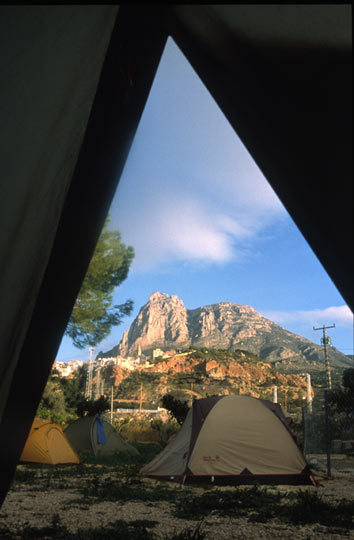
[Photo] Traveler Taj Terpening
We followed this route with El Navigante (5.11d, 165m). Since the Penon is a monolith and not a flat cliff, every move on every climb feels like an arete. Making matters worse (and at the same time more exciting) is the wind and thunderous racket of the crashing waves bellow. We topped out El Navigante just as the sun descended into the haze over North Africa and washed the white cliffs in red and orange. As the sky darkened and the pale stars emerged, gulls clinging to the last of the sea breeze shrieked mournfully overhead. The white spots of their bodies moved in and out of the stars like drifting constellations. We ate, and Cass brought out a hidden flask, a splendid Newcastle tradition.
Later that night we were bored and our collective male energy bred a machismo none of us possessed on our own. I suggested we go back to the Penon and climb it in the dark. “Bloody hell, its 11 at night! Crazy Yank.”
But the idea gained popularity, and soon we found ourselves in the car racing back, eager to climb. Each leader of our two parties got three headlights, one for each knee to illuminate their feet and one for their head. The night was cool and still, and the light from Calpe backlit the Penon. Reaching a small ridge after four fun and quick pitches, we looked down to see if we could spot our cars. A light flashed so I flashed my headlight back wondering what I was saying in Morris Code. When the light went dark we saw that the light’s source was two cops standing near our cars.
We couldn’t figure out what they wanted, so we devised a plan as we continued up the last two pitches. We’d hike down the trail–but before we reached the car we would all hide. One of us would pretend to be a jogger who would run nonchalantly past the cops, jump in the car and come back for the rest of us. It seemed foolproof until we rounded a bend on our descent and saw the cops in the trail peering at us through the gloom. As we approached, I yelled out, “Hey you wankers!” as a test to see if they spoke English. I had recently learned this very profane bit of British slang, and I felt obliged to use it whenever possible, just to master its use. The officers didn’t flinch, so we knew we had a code language to converse amongst ourselves. First we tried simply to steer around them, suggesting with our body language that we were not in fact the climbers they were looking for and that the real culprits would be down shortly. They intercepted us and began shouting in the kind of obscenely fast and aggressive Spanish you hear on Spanish sports radio stations.
I spoke a little Spanish, and true to their oblivious traveling style, the Brits spoke none. I caught the words “jail” and “crimes,” but I couldn’t gather the specifics of our offense or what the jail time would be. I stepped forward to explain everything in fluent “Spanglish.” I described how the British guys had abducted me and forced me to climb with them. Furthermore, I said, I was ecstatic to see the authorities so I finally could be safe. The younger officer, who had been so irate a moment ago, stared at me with a blank face. Then they both started laughing. It broke the ice, but they wouldn’t let us go. A heinous crime had been committed, and it didn’t seem to matter that neither the police nor us knew what it was.
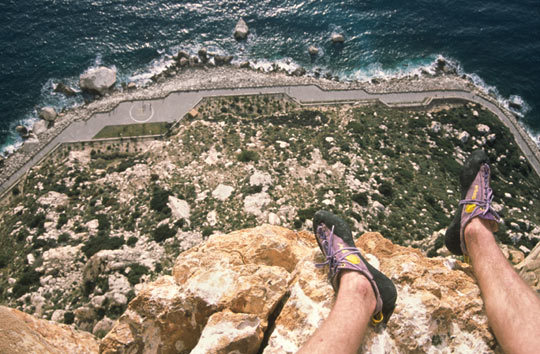
[Photo] Traveler Taj Terpening
After a brief chat with their superior over the radio, the cops finally accepted that they couldn’t arrest us for simply climbing at night. Resigned to another night with no action, they asked us for our passports to record our info. Alas, they had us on something! We didn’t have our passports with us. I tried to explain that we did have passports, but had left them back at the flat because we were climbing, but the fuzz wasn’t buying it. Another few minutes of arguing and I suddenly remembered I had cleverly made a color copy of my passport and stashed it under the insole of my shoe. Gleeful, I jumped around on one foot, trying to pull off my shoe. The cops and the Brits looked on curiously. The shoe popped off my foot, and I proudly extracted the soggy, stinky, limp piece of paper. Glowing with pride at my resourcefulness, I held the document out for the cops. They looked at it, at me and back and forth at one another, seeming to dare each other to take it. After a long and awkward moment, the older cop shook his head and said, “No es normal.” They silently turned and left.
The next morning Cass and I found ourselves on the Road to Nowhere, Cass trying to photograph the speedometer. We had devised the game when we realized that the cheap cars we were driving didn’t have enough horsepower to get more than two passengers up a hill, which in mountainous La Costa Blanca would have relegated us to the airport tarmac and little more. Thus, we had two cars for four people; so much for European fuel economy. At the end of each day the person with photographic proof of the top speed won. They received a shot of Schnapps, an extra piece of white bread and a pat on the back.
The Road to Nowhere climbed ahead of us at an alarming rate with a menacing cliff straight into the sea on the left and a sheer wall of white limestone rising on the right. Just as I was going to suggest another adventure might be more suitable for ending our trip–not because I was scared, but for the sake of the rental car–Cass pounced on the accelerator, and we were off. Rounding a corner on two wheels and in the wrong lane we saw a series of car-eating craters that marked the road’s transition from cement to gravel.
“Hey!” Cass shouted over the sound of the car falling apart. “In the UK, we’ve got this show, like James Bond, you know?” He paused to contemplate the speed, no doubt not questioning its safety but wondering if it was worth taking a photo. “Anyway, in this one episode he’s rippin’ down this road in an Aston Martin or whatever and he comes to a bit like this.” He gestured toward the holes ahead. “He came to a bit like this and instead of slowing, he sped up!”
His tone suggested an epiphany, as in: All this time I’ve been slowing down for these things when I should have been speeding up! He sped up, taking up both lanes with the tiny car, racing toward yet another certain doom. With the engine reaching a crescendo doing 130 km/h in third gear, Cass took a picture of the speedometer and continued. “He just glided over the holes and was on his way!”
In the ensuing moment when I thought death imminent, my life did not pass before my eyes; God did not speak soothing words. Instead, a bird casually flying to his nest splattered across the windshield, and we sailed headlong into the first of the craters.
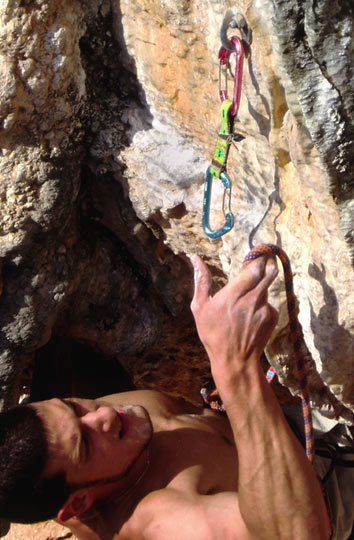
[Photo] Traveler Taj Terpening
Then the front of the car went airborne before plunging into the second, even larger hole. The car stopped but began shaking so violently the CD stopped, the windshield wipers turned on and our vision blurred. Cass switched off the ignition and we sat silently for a moment, reveling in our aliveness. All that was necessary to identify the source of the shaking was to open the hood. The tiny engine had three major bolts attaching it to the car in a tripod configuration. One of them was broken so when the car was running the engine twisted back and forth like a swinging hammock. Too hilarious to not share with everyone, Cass called his friends who had stayed home that day. While I dwelled on the long-term ramifications of wrecking a rental car, Cass and the others stood around the car barely able to speak between fits of laughter.
“Hey Cass, you’re proper fucked now mate!”
“Yea but it was worth it. Besides, Traveler has something to write home about now.”
“Hey, what do you recon the breaking strength is of an R-29 bolt, eh?”
“I don’t know mate, that hole was horrific though!”
But like the end of any great trip, we had mangled fingers, forearms too pumped to brush our teeth at night, a wrecked car and still enough psych to get up another climb. Leaving the car “parked” where it was, we decided we would contemplate our situation while climbing a famous sea cliff route we’d been eyeing in the guidebook that happened to be just down from our perch on the cliff. The route, Via Missing Link (5.10d) was a spectacular and scary-looking 90-degree arete rising 160 feet straight out of the ocean.
The approach involved gearing up on a beach, then traversing horizontally for 90 feet with the sea soaking your shoes. Once at the arete, the belayer has to hold his legs up to keep from getting wet while he yells at the leader to climb faster. Anything less than a tight belay around the first and second bolts would mean a dip in the ocean, were the leader to fall. Cool as the character in Cass’s TV show, I ascended the arete while Cass yelled for me to hurry. After dealing with sadistic airlines, a week in a cave with a family of rodents, eating ninety-eight oranges in six days, a month of feeling like my death was just around every curve in the road with Cass at the wheel and being in a car wreck, this climb was cake.
Back at the car, the solution to our problem soon presented itself in the form of a 2-meter length of purple webbing. I took a few turns around the engine, then tied it to the underside of the hood. When we fired the engine, the ride was smooth and quiet.
Two days later Cass and I screeched to a halt in front of the rental car agency at the Alicante airport. With the music still blaring and the car beginning to shake again, Cass threw the keys to the attendant, and we each strode off in different directions, yelling goodbyes to each other as we went. After doing some loops around the airport to throw off any rental car agents who may have been looking for him, he boarded a flight back to Newcastle. After my own defensive maneuvers I once again found myself in front of the Alicante airport trolling for a partner.
A week later I got a text message from Cass: “After I took off I used the in-flight phone to cancel the credit card I rented the car with. Ha! We win again!”
Please check out more of Traveler’s work at www.travelerphotography.com, and feel free to give him a shout if you want to know more about La Costa Blanca, El Chorro or his photography.

[Photo] Traveler Taj Terpening